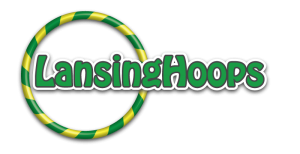 I just got back from hosting the first ever Michigan Hoop Dance Retreat. Man, was it a blast! I was in charge of booking the grounds, scheduling and paying instructors, answering questions, setting up camp, and dealing with any issues that came up during the 3-day retreat. All together 38 hoopers, 4 flow teachers, and a handful of spouses gathered to share in a weekend of fun, learning, and relaxation.
I just got back from hosting the first ever Michigan Hoop Dance Retreat. Man, was it a blast! I was in charge of booking the grounds, scheduling and paying instructors, answering questions, setting up camp, and dealing with any issues that came up during the 3-day retreat. All together 38 hoopers, 4 flow teachers, and a handful of spouses gathered to share in a weekend of fun, learning, and relaxation.
As host, I was a little concerned when the campground reserved half the space promised and we had to squeeze into 6 sites! But, everyone smiled and laughed at the absurdity, and accepted our festie-style quarters. Later, when I went to check out our play area, I was again met with half the space we were promised…this time covered in goose poop.
I could feel my anxiety spiraling until I remembered Jen Spiece, from IMAJENation Hoop Revival, was at the retreat. As a fellow Hoop Love Coach, I knew I could privately freak out and then get some much needed advice on what to do. Being able to open up to Jen, and say, “I don’t know what I’m doing, heelllpp!!” was my saving grace. Saturday was packed full of workshops and afterward several attendees asked how they could teach at next year’s retreat, or get started instructing in their own areas.
Teaching is one of the best ways to improve your own hoop dance skills, and has the added benefit of helping others. Plus, it is awesome to see flow artists excited about sharing the love in their own towns. But, a good flow teacher is more than someone who hoops well.
Prior to becoming a hoop dance instructor, I earned my 2nd Degree Black Belt and Master Instructor-ship in the American Advanced Combat System. Before that I was a color guard captain and choreographer. I also run an online hoop dance course called Learn to Hoop at Home that teaches students how to hoop dance from the comfort of their living rooms. In my experience, as an instructor for over 15 years, there are certain things that make someone a good flow teacher.
Become a Better Flow Instructor Today
Learn the Technique Without your Prop
 Sometimes, as flow artists, we’re so excited to learn new techniques and combos that we never slow down and actually think about what we’re doing. This is fine when you’re just hooping for yourself. But as a flow instructor, you need to understand what your body is doing, what your hands are doing, and what your mind is thinking, as you flow through each technique. Otherwise it is impossible for you to break it down and share with others.
Sometimes, as flow artists, we’re so excited to learn new techniques and combos that we never slow down and actually think about what we’re doing. This is fine when you’re just hooping for yourself. But as a flow instructor, you need to understand what your body is doing, what your hands are doing, and what your mind is thinking, as you flow through each technique. Otherwise it is impossible for you to break it down and share with others.
One way you can figure out what your body is doing is to get rid of your prop. Flow through each motion as if you were holding on to your hoop. What are your fingers doing? What are your wrists doing? Which way are your feet turned?
When you’re holding your prop, it becomes the main focus of what you’re doing. By removing it, you put your body back in the forefront and can think through what it’s doing. When teaching others, what your body does is just as, and sometimes more, important than what the hoop is doing.
Learn to do the Technique Slowly
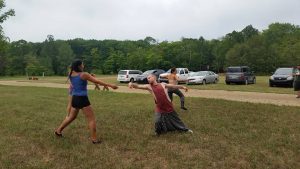 Most people, once learning a technique at regular speed, try to do it faster. But, as a hoop dance instructor, the real skill is in learning to slow down. Just like learning without your prop, practicing slowly takes takes focus, concentration, and a full understanding of what your body is doing. If you can do it slow, you can do it fast. If you can’t do it slow, keep practicing! 😉
Most people, once learning a technique at regular speed, try to do it faster. But, as a hoop dance instructor, the real skill is in learning to slow down. Just like learning without your prop, practicing slowly takes takes focus, concentration, and a full understanding of what your body is doing. If you can do it slow, you can do it fast. If you can’t do it slow, keep practicing! 😉
Tell then Show then Involve
 With the tell-show-involve technique, you capture your students attention first, and then allow them to practice on their own. First, tell your students what you’re going to teach them. This can be as simple as giving them the name of the trick or the type of lesson you’re teaching (i.e. core, spins, etc), or can be more in-depth. The important thing to remember when you’re ‘telling’, is that you only need to give them as much information as they need to understand what to do next…in other words, don’t go on and on at this stage. Students are pumped to use their hoops, and don’t want to hold still to listen for long.
With the tell-show-involve technique, you capture your students attention first, and then allow them to practice on their own. First, tell your students what you’re going to teach them. This can be as simple as giving them the name of the trick or the type of lesson you’re teaching (i.e. core, spins, etc), or can be more in-depth. The important thing to remember when you’re ‘telling’, is that you only need to give them as much information as they need to understand what to do next…in other words, don’t go on and on at this stage. Students are pumped to use their hoops, and don’t want to hold still to listen for long.
After you tell them what they’re going to do, show them what they’re going to do. This consists of demonstrating the trick or sequence, and sometimes, inserting it into your own flow so they can see how it will play out. You can still be ‘telling’ during this stage. Use your demonstration time to point out specific aspects of the technique you want your students to notice.
Next, involve them in learning. This is when you invite them to practice with you. You can do this by combining what you just “told and showed”, by telling again and showing again while they follow along with you slowly step-by-step. So, you might say, “Okay, now, put your hoop in your right hand like this. Now, mirroring me, slowly start to lift your arm…..”.
Instructors who ‘tell’ too much bore their students. Instructors who ‘show’ too much overwhelm their students. Flow teachers who slow down and involve their students, wow their students.
Get Your Student to Share the Technique
H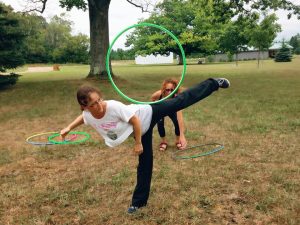 ow can you tell if your student really understands what you have been teaching?
ow can you tell if your student really understands what you have been teaching?
One great way, that also reinforces what you just taught, is to get the student to share their understanding with you. You do this by asking them open-ended questions like ‘How does that feel?’, ‘What do you think your arms are doing?’, ‘What should your back be doing?’, ‘What is another way you can achieve the same thing?’.
By getting them to share with you, you can assess whether or not they understand. But, you’re also prompting them to learn the first step of teaching aka ‘telling’. It’s one thing to be able to do something. It’s another thing to be able to say what you’re doing. If you can say it, you can remember it.
Pretend Your Students are Blindfolded
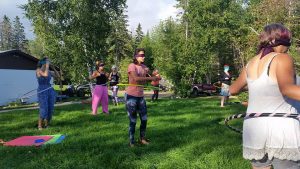 There are thousands of hoop dance tutorials on YouTube. But, when someone asks where they can learn online, the number one answer given is to check out Deanne Love’s Hoop Lovers channel. So, what makes Deanne’s instruction so much better than all those other videos?
There are thousands of hoop dance tutorials on YouTube. But, when someone asks where they can learn online, the number one answer given is to check out Deanne Love’s Hoop Lovers channel. So, what makes Deanne’s instruction so much better than all those other videos?
It’s that you don’t have to be watching them to figure out what you’re supposed to do. Deanne uses stories, metaphors, and adjectives to help you understand what your body AND your hoop are supposed to be doing. She teaches as if her students were blindfolded, which opens them up to a 3D learning experience.
Instead of blindly watching and then trying to copy, or following along at breakneck speed and trying to keep up, juicy descriptions allow your student to use all of their senses, instead of just sight. This creates for a much smoother learning experience.
The Time to Start is Now
There has never been a better time to start teaching than right now. So grab your bestie, sister, mom, neighbor, the kid next door, your landlord, or the guy that always steals your parking spot, and throw an impromptu hoop lesson. The only way to be a better hoop dance teacher is to become any kind of instructor in the first place.
You won’t know it all. You’ll mess up. Your students will ask you something you don’t know. You’ll embarrass yourself. But, you’ll pick yourself up and be stronger for it. And you’ll be better. So get started today.
It’s Easier to ask for Forgiveness than Permission
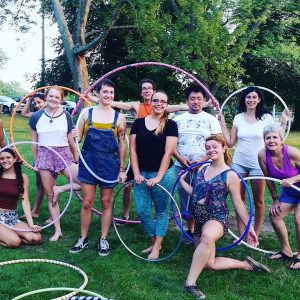 Not sure if you can hold a hoop dance class in your park? Not sure where to get a sales tax license, business license, insurance, or anything else you need? Not sure who to ask?
Not sure if you can hold a hoop dance class in your park? Not sure where to get a sales tax license, business license, insurance, or anything else you need? Not sure who to ask?
Just hold the class anyway.
Do this at your own risk, but I have never had someone tell me to stop holding a jam, a class, or any other hoop related event. No one has ever asked to see my license, where I got certified, or who my contacts are. In general, if you’re not blatantly doing something questionable, most people won’t question you.
So, don’t try to set up a hoop dance class in the middle of an event unless you have permission from the organizer. Do, try to set up a hoop dance class in the middle of your local park. Don’t argue if someone asks you to leave. Do reschedule the class for a different park or ask how you can get future permission to instruct there.
Keep in mind, the bigger your classes get, the more attention you draw to yourself. A 6-person class looks a lot different than a 50-person class. Expect more questions as you get bigger.
Don’t Wait for Buy-In
Don’t ask your friends if they want to take a class. Don’t ask what days work best. Don’t go looking for permission from the park authorities to hold a class. There will never be a time when you feel like people you are ready for your class. No one will come knocking on your door wondering when you’re going to get started. Sometimes, friends who know you’ve been teaching for months, will insist they had no idea you’re running a class. The friends who promised they would share your flyers and posts, are no where to be found.
The people who tell you they will show up, won’t. This is normal and totally expected. It’s not that people are jerks. It’s that they’re excited for you and don’t realize your decision to run a class is hinging on their flippant ‘Sure, yeah, that sounds fun!’ Just schedule it. The people who care will show up. But…
No One Will Ever Care as Much as You Do
Your flow class is your baby. No one else is going to take care of it, nurture it, or talk about how great it is. Just like a proud parent, you will love and care for your class more than anyone else ever will. Some days, it will feel like no one cares at all, but it’s your job to keep lifting it up, promoting it, and encouraging it to grow.
Other days, it will feel like your class is growing too fast, like you’re losing control and you want it to slow down and be little again. You will long for the days when you worried your class wasn’t big enough, when you were only teaching one skill level, and every had space to spread out. Your growth will scare you while it invigorates your students. And still, no one will care as much as you do.
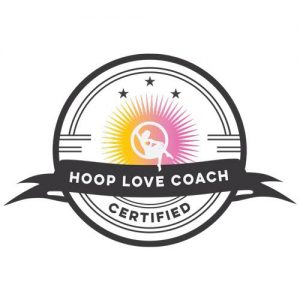 But There Are People Who Care
But There Are People Who Care
Just because no one cares about your hoop class as much as you do, there are people who care about their own classes as much as you care about yours, and those people will get you through the hard times. One of the best things you can do as a hoop instructor is to make friends with other flow instructors. These people are a wealth of support, information, assistance, and inspiration. When you know and actively help others who are doing and achieving the same things you want to do and achieve, your growth will be exponential.
If you’re serious about becoming a flow teacher and are looking for a an easy step-by-step plan, I recommend Deanne Love’s Hoop Love Coach training program. You will receive hundreds of trick tutorials, lesson plan breakdowns, access to special deals and discounts. And, most importantly, you will gain access to the private Hoop Love Coach online forum where Deanne, and hundreds of Hoop Love Coaches worldwide, are available to answer your questions and help you get started today. Click this link to find more about Hoop Love Coach Training today. The program starts on September 1st!
Click this link to read more about my experience with the Hoop Love Coach training program.
*As an HLC affiliate, if you decide to purchase this program after clicking on a link from this page, I will receive a small commission. The cost to you is the same.
